Cox
Orange Pippin
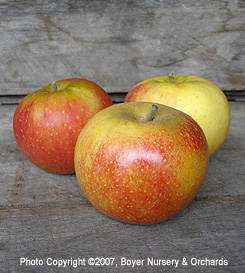
Cox
Orange Pippin is an English variety discovered around 1825.
It
was, and still is, known as a consumate dessert apple, and it has been
the progenitor of many modern varieties. While still popular
in
Europe, it is all but unknown in the United States, owing partly to the
difficulty in growing it. The fruit is firm, juicy, aromatic
with
a cream-colored flesh. By the way, the term, pippin, means
that the original tree was a chance seedling that grew from an apple
dropped from a tree.
|
Empire
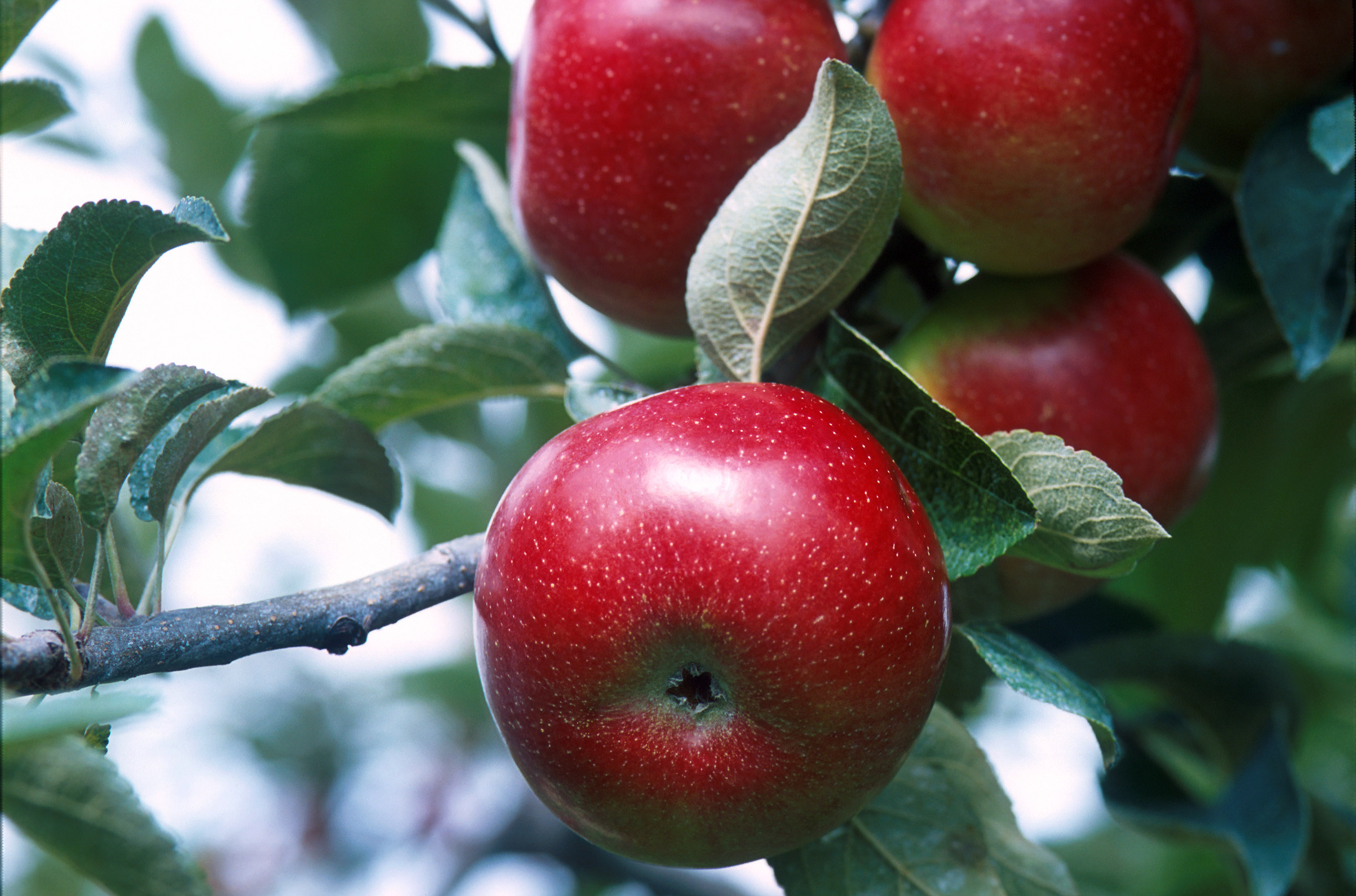 Introduced
in 1966 by Cornell University's Geneva breeding program, Empire is a
cross between Red Delicious and MacIntosh. It is red, round,
medium sized and full of eye-appeal. It is most similar to
MacIntosh in flavor, with juicy, creamy white flesh that is nice and
crisp. Empire is more sweet than tart for those who shy away
from
a tart apple. Introduced
in 1966 by Cornell University's Geneva breeding program, Empire is a
cross between Red Delicious and MacIntosh. It is red, round,
medium sized and full of eye-appeal. It is most similar to
MacIntosh in flavor, with juicy, creamy white flesh that is nice and
crisp. Empire is more sweet than tart for those who shy away
from
a tart apple.
|
Enterprise
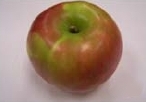 Enterprise
has a large, red, juicy fruit and is good for fresh
eating as well as in salads, and stores well. It is ready
approximately 3 weeks after Delicious, putting it in the early October
timeframe. Moderately acid at harvest, the quality is
outstanding
after 1 to 2 months of storage if you like a milder apple.
The
flesh is fine-grained, pale yellow to cream colored, firm and crisp.
The fruit is round to moderately elongated with a bright,
glossy
finish and moderately thick skin. Enterprise
has a large, red, juicy fruit and is good for fresh
eating as well as in salads, and stores well. It is ready
approximately 3 weeks after Delicious, putting it in the early October
timeframe. Moderately acid at harvest, the quality is
outstanding
after 1 to 2 months of storage if you like a milder apple.
The
flesh is fine-grained, pale yellow to cream colored, firm and crisp.
The fruit is round to moderately elongated with a bright,
glossy
finish and moderately thick skin.
|
Fuji
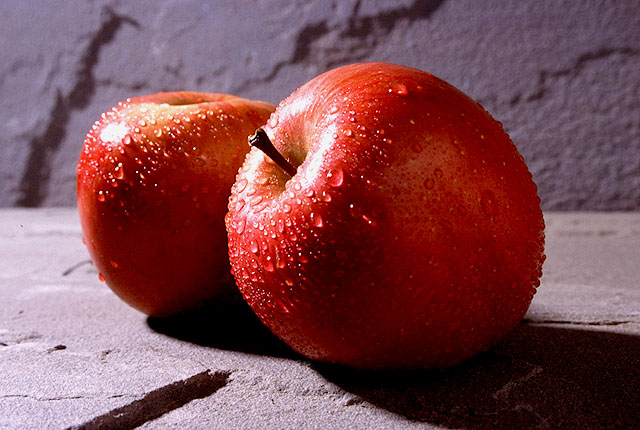 Fuji
sounds Japanese for a reason, it was developed in Japan in the 1930s
and made it to market in 1962.
However, Fuji is all-American when it comes to its origins.
Its parents are Red Delicious and Ralls Janet, American
apples
with a long history. Ralls Janet dates back to the late 18th
century and was reportedly named by Thomas Jefferson. Fuji is
very popular in Japan and China, and is becoming
more popular in the United States. The flesh is firm and fine
with a cream color. It is sweet and juicy and consistently
scores
high in taste tests. Fuji
sounds Japanese for a reason, it was developed in Japan in the 1930s
and made it to market in 1962.
However, Fuji is all-American when it comes to its origins.
Its parents are Red Delicious and Ralls Janet, American
apples
with a long history. Ralls Janet dates back to the late 18th
century and was reportedly named by Thomas Jefferson. Fuji is
very popular in Japan and China, and is becoming
more popular in the United States. The flesh is firm and fine
with a cream color. It is sweet and juicy and consistently
scores
high in taste tests.
|
Crimson
Gala
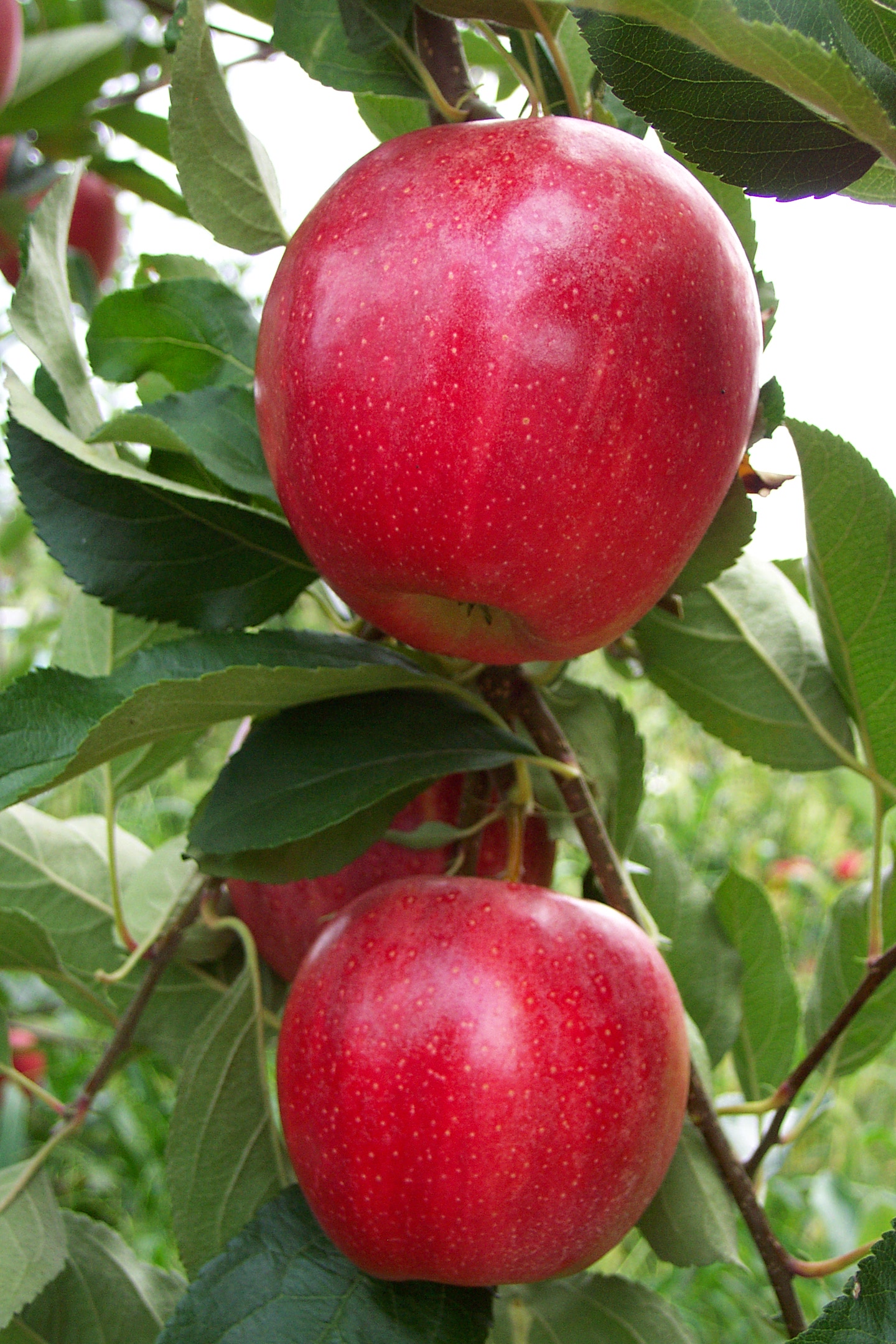 The
original Gala apple is native to New Zealand. It comes from
a cross between the Kidd's Orange Red and Golden
Delicious. Gala was introduced to the United States
in the 1970s.
Because of its popularity, many different "sports" of Gala
have
been propogated, each having some beneficial characteristic.
In
general, Gala is a very "safe" apple. Not too sweet or tart,
no
unusual tastes or textures, but offering a very pleasing aroma and
eating experience. Crimson Gala is
characterized by intense coloring and striping. It was
discovered
in a block of Royal Gala in Milton-Freewater, Oregon and is a patented
variety. The
original Gala apple is native to New Zealand. It comes from
a cross between the Kidd's Orange Red and Golden
Delicious. Gala was introduced to the United States
in the 1970s.
Because of its popularity, many different "sports" of Gala
have
been propogated, each having some beneficial characteristic.
In
general, Gala is a very "safe" apple. Not too sweet or tart,
no
unusual tastes or textures, but offering a very pleasing aroma and
eating experience. Crimson Gala is
characterized by intense coloring and striping. It was
discovered
in a block of Royal Gala in Milton-Freewater, Oregon and is a patented
variety.
|
Fulford
Gala
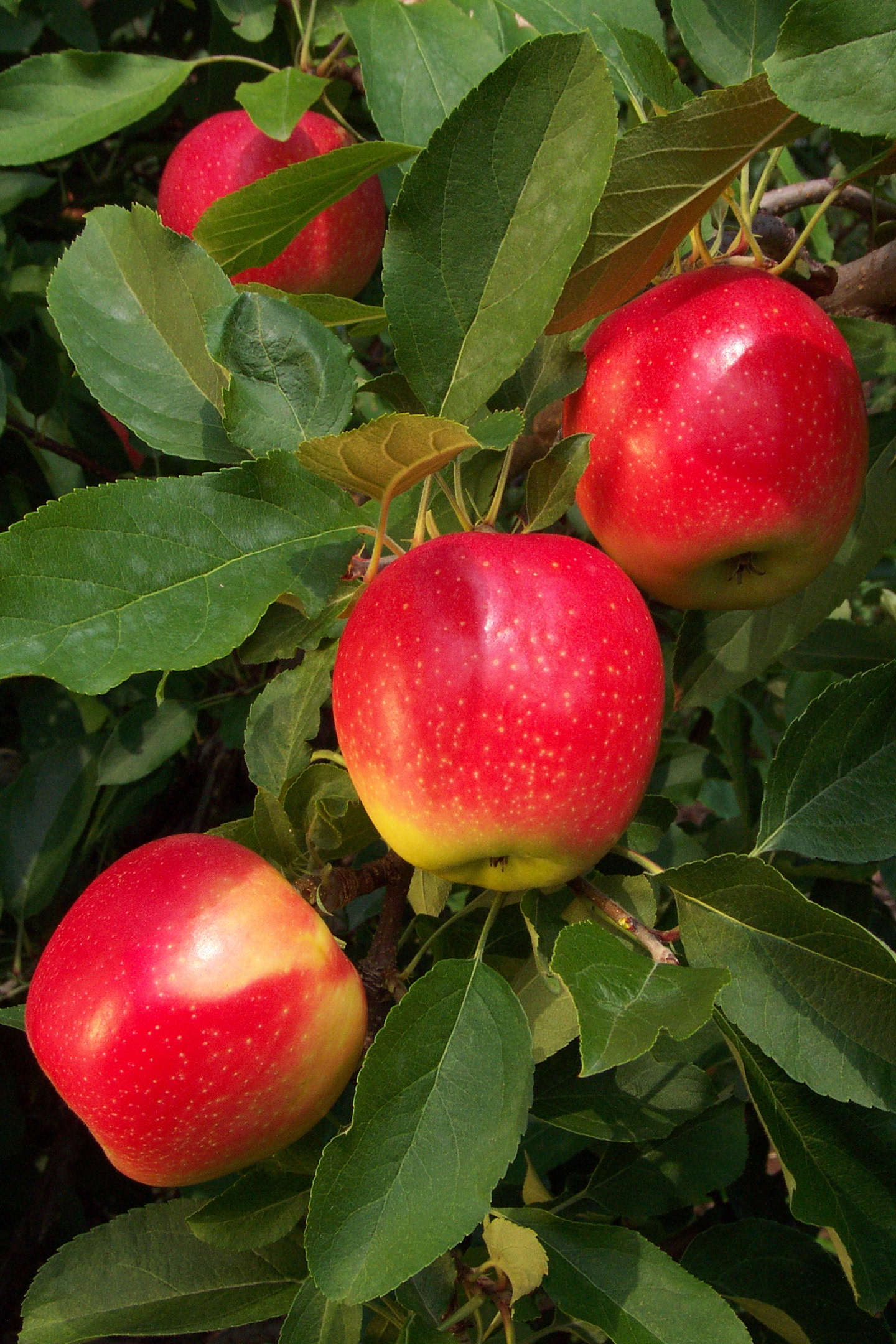 The
original Gala apple is native to New Zealand. It
comes from
a cross between the Kidd's Orange Red and Golden
Delicious. Gala was introduced to the United States
in the 1970s.
Because of its
popularity, many different "sports" of Gala have been propogated, each
having some beneficial characteristic. In general, Gala is a
very "safe" apple. Not too sweet or sour, no
unusual tastes or textures, but offering a very pleasing aroma and
eating experience. Fulford Gala hails from New Zealand.
Its color is a bright
orange-red with yellow background. Fulford Gala is a larger sized Gala,
with a blush red rather than stripe. Like
Crimson Gala, Fulford Gala is a patented variety. The
original Gala apple is native to New Zealand. It
comes from
a cross between the Kidd's Orange Red and Golden
Delicious. Gala was introduced to the United States
in the 1970s.
Because of its
popularity, many different "sports" of Gala have been propogated, each
having some beneficial characteristic. In general, Gala is a
very "safe" apple. Not too sweet or sour, no
unusual tastes or textures, but offering a very pleasing aroma and
eating experience. Fulford Gala hails from New Zealand.
Its color is a bright
orange-red with yellow background. Fulford Gala is a larger sized Gala,
with a blush red rather than stripe. Like
Crimson Gala, Fulford Gala is a patented variety.
|
Golden
Delicious
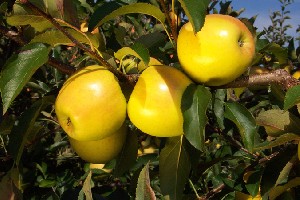 Golden
Delicious is currently the second most popular apple in the US, after
Red Delicious. Unlike Red Delicious, there
is a good
reason
for the popularity of Golden Delicious, and the two are related in name
only. It originated in Virginia in the early part of the 20th
century and was popularized by Stark Brothers. Golden
Delicious
is great for just about any use and makes a great sauce. The
flesh is yellowish, moderately firm, very juicy, and sweet
with a bit of tang. Golden Delicious also has a wonderful,
spicy aroma. Golden
Delicious is currently the second most popular apple in the US, after
Red Delicious. Unlike Red Delicious, there
is a good
reason
for the popularity of Golden Delicious, and the two are related in name
only. It originated in Virginia in the early part of the 20th
century and was popularized by Stark Brothers. Golden
Delicious
is great for just about any use and makes a great sauce. The
flesh is yellowish, moderately firm, very juicy, and sweet
with a bit of tang. Golden Delicious also has a wonderful,
spicy aroma.
|
Golden
Russet
 In
the
1905 book, The
Apples of New York, Volume I,
Golden Russet was said to rank second only to Roxbury in terms of
commercial importance for russet apples. Nowadays, most
people
don't even know what a russet apple is. Russet is a rough
scale
on the surface of the apple. It can occur in many varieties,
but
is the norm in some - the russet apples. The importance of
russet
apples in the 19th century was long keeping quality. Today,
this
characteristic has been replaced by cold storage. Golden
Russet
is good for cooking, drying and cider, as well as eating. Due
to
the russeted skin, it is best peeled before eating. The fruit
is
smallish, round and generally oblate. The flesh is yellowish,
fine grained, moderately crisp, tender, juicy, rich, agreeably subacid,
and aromatic. Golden Russet is a fairly late apple with a
season
from October to April. In
the
1905 book, The
Apples of New York, Volume I,
Golden Russet was said to rank second only to Roxbury in terms of
commercial importance for russet apples. Nowadays, most
people
don't even know what a russet apple is. Russet is a rough
scale
on the surface of the apple. It can occur in many varieties,
but
is the norm in some - the russet apples. The importance of
russet
apples in the 19th century was long keeping quality. Today,
this
characteristic has been replaced by cold storage. Golden
Russet
is good for cooking, drying and cider, as well as eating. Due
to
the russeted skin, it is best peeled before eating. The fruit
is
smallish, round and generally oblate. The flesh is yellowish,
fine grained, moderately crisp, tender, juicy, rich, agreeably subacid,
and aromatic. Golden Russet is a fairly late apple with a
season
from October to April.
|
Goldrush
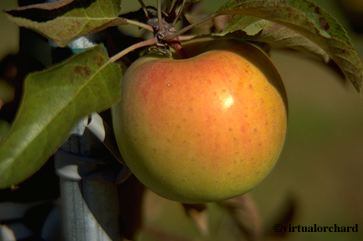 Goldrush
is a recent, patented variety, coming to market in only 1992.
Best
known for its remarkable keeping
qualities (10-11 months) and sweet/tart very crisp flavor. GoldRush
resists
oxidation when cut, making a very yellow sauce or firm crisp slices for
baking.
One of the last apples to be picked, usually in early
November,
Goldrush starts out with a very "sweettart" character. If you
like a tart bite that ends sweet, this one is for you. And if
you
don't, this one is for you, too, because it gets nice and sweet after
beings stored for a while. We call this "the Christmas Apple"
because it keeps 'til then with no effort and is at peak flavor.
This is one of our favorites for all uses, fresh eating,
sauce
and baking. Goldrush
is a recent, patented variety, coming to market in only 1992.
Best
known for its remarkable keeping
qualities (10-11 months) and sweet/tart very crisp flavor. GoldRush
resists
oxidation when cut, making a very yellow sauce or firm crisp slices for
baking.
One of the last apples to be picked, usually in early
November,
Goldrush starts out with a very "sweettart" character. If you
like a tart bite that ends sweet, this one is for you. And if
you
don't, this one is for you, too, because it gets nice and sweet after
beings stored for a while. We call this "the Christmas Apple"
because it keeps 'til then with no effort and is at peak flavor.
This is one of our favorites for all uses, fresh eating,
sauce
and baking.
|
Granny
Smith
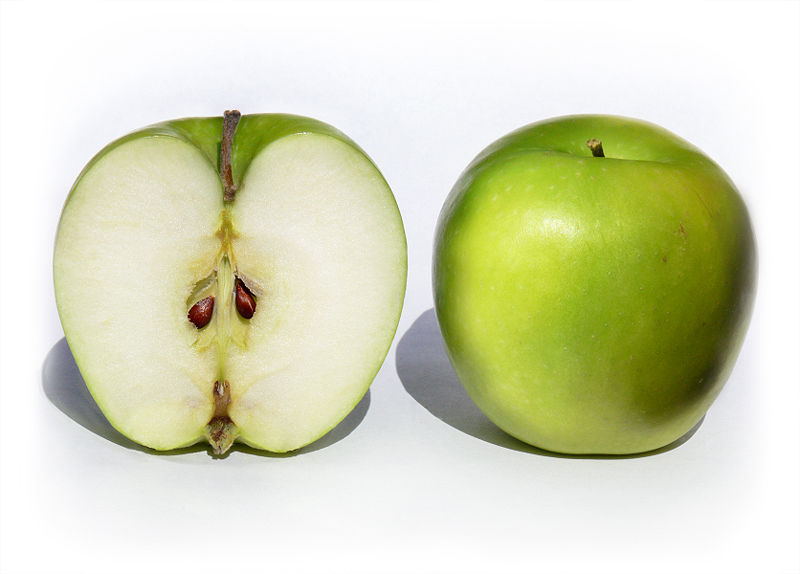 Granny
Smith is what everyone thinks of when they think of a green apple.
Granny is a native of New Zealand. The real "Granny
Smith" was Maria Ann
Sherwood Smith who discovered the apple in a chance sport from some
French crab apples grown in Tasmania. It was first noted in
1868,
but did not gain notariety as a commercial strain until the late 1890s.
The Granny Smith apple is large, firm, crisp and very juicy
with a tart,
sprightly taste. It is not aromatic. Granny bakes very well. Granny
Smith is what everyone thinks of when they think of a green apple.
Granny is a native of New Zealand. The real "Granny
Smith" was Maria Ann
Sherwood Smith who discovered the apple in a chance sport from some
French crab apples grown in Tasmania. It was first noted in
1868,
but did not gain notariety as a commercial strain until the late 1890s.
The Granny Smith apple is large, firm, crisp and very juicy
with a tart,
sprightly taste. It is not aromatic. Granny bakes very well.
|
Gravenstein
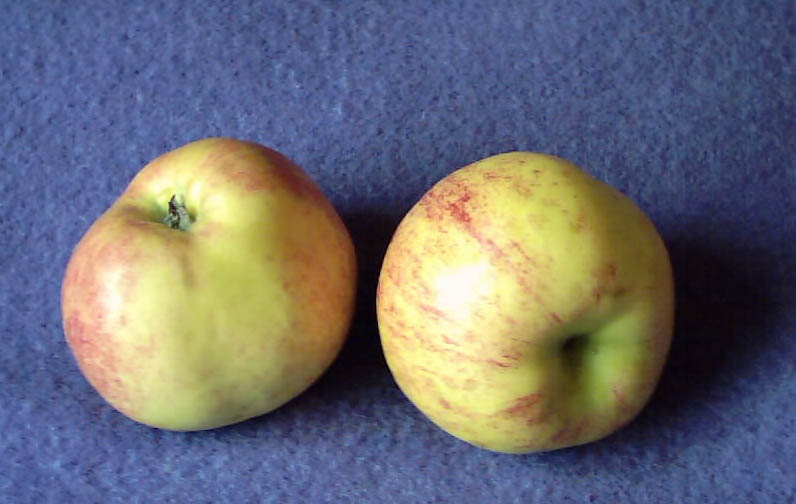 Gravenstein is a very old
variety,
originating about 1669 in Denmark. It is an early apple,
coming into season in early August and is adaptable in it's uses.
Gravenstein is often "lumpy" in appearance and may run from
lightly striped with red to orange over green depending on what sport
is cultivated. It has a sweet-tart flavor and is very good
for cooking as well as fresh eating. Because it is a summer
apple, it does not last long, but can be preserved as sauce due to its
cooking qualities. Gravenstein is a very old
variety,
originating about 1669 in Denmark. It is an early apple,
coming into season in early August and is adaptable in it's uses.
Gravenstein is often "lumpy" in appearance and may run from
lightly striped with red to orange over green depending on what sport
is cultivated. It has a sweet-tart flavor and is very good
for cooking as well as fresh eating. Because it is a summer
apple, it does not last long, but can be preserved as sauce due to its
cooking qualities.
|
Honeycrisp
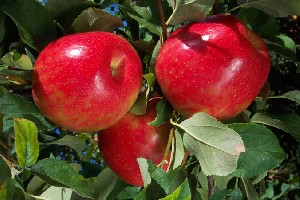 Honeycrisp
is a patented cross between favorites Macoun and Honeygold produced at
the
University of Minnesota in the late 1970s. They describe
Honeycrisp this way (taken from honeycrisp.org and edited for length):
Honeycrisp
apples are
oblate to roundly oblate in shape. Skin color is mottled red
over a yellow background. A nearly solid red
coloration develops only if the fruit is well exposed to the
sun. Honeycrisp fruit is exceptionally crisp
and juicy. Its flesh is cream colored and coarse. The flavor is
sub-acid
and ranges from mild and well-balanced to strongly aromatic, depending
on the
degree of maturity. It has consistently ranked as one of the highest
quality
apples in the University of Minnesota sensory
evaluations. Honeycrisp fruit has shown excellent storage
characteristics. Honeycrisp
really is a delicious
apple and does have a honey-like aftertaste. It is hard to
grow, but that is my problem, not yours! Honeycrisp
is a patented cross between favorites Macoun and Honeygold produced at
the
University of Minnesota in the late 1970s. They describe
Honeycrisp this way (taken from honeycrisp.org and edited for length):
Honeycrisp
apples are
oblate to roundly oblate in shape. Skin color is mottled red
over a yellow background. A nearly solid red
coloration develops only if the fruit is well exposed to the
sun. Honeycrisp fruit is exceptionally crisp
and juicy. Its flesh is cream colored and coarse. The flavor is
sub-acid
and ranges from mild and well-balanced to strongly aromatic, depending
on the
degree of maturity. It has consistently ranked as one of the highest
quality
apples in the University of Minnesota sensory
evaluations. Honeycrisp fruit has shown excellent storage
characteristics. Honeycrisp
really is a delicious
apple and does have a honey-like aftertaste. It is hard to
grow, but that is my problem, not yours!
|
Liberty
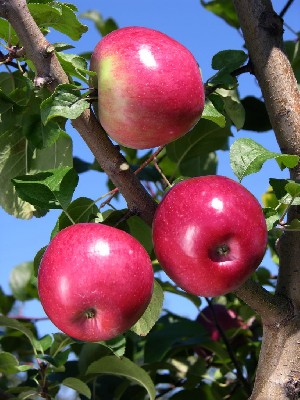 Liberty
is a cross between Macoun and Purdue 54-12 from Purdue University and
released through Cornell University in 1978. A 1978 Cornell
University publication describes Liberty, in part, like this: 'Liberty'
is a deep dark red over a yellowish background. The red is striped
rather than blushed. The shape of the
fruit is oblate to oblate conic, and the size averages 2 3/4-3
inches. The flesh is yellowish in color, juicy,
crisp,
fine. The flavor is subacid and good. 'Liberty' is considered
to be primarily
a dessert apple.Liberty
is a really tasty apple for eating out of hand. I think the
flesh
is more white than yellow. My only crisicism of Liberty is
that
the flesh browns quickly in the air. This is a cosmetic issue
and
isn't a problem for eating out of hand. If served cut at the
table or in fruit salad, slices can be dipped in water containing a bit
of lemon juice and the "problem" is solved. Liberty
is a cross between Macoun and Purdue 54-12 from Purdue University and
released through Cornell University in 1978. A 1978 Cornell
University publication describes Liberty, in part, like this: 'Liberty'
is a deep dark red over a yellowish background. The red is striped
rather than blushed. The shape of the
fruit is oblate to oblate conic, and the size averages 2 3/4-3
inches. The flesh is yellowish in color, juicy,
crisp,
fine. The flavor is subacid and good. 'Liberty' is considered
to be primarily
a dessert apple.Liberty
is a really tasty apple for eating out of hand. I think the
flesh
is more white than yellow. My only crisicism of Liberty is
that
the flesh browns quickly in the air. This is a cosmetic issue
and
isn't a problem for eating out of hand. If served cut at the
table or in fruit salad, slices can be dipped in water containing a bit
of lemon juice and the "problem" is solved.
|
Northern
Spy
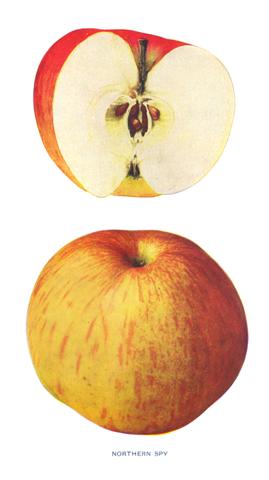 Northern
Spy is what my grandmother used to make applesauce. I know,
because as a child I tasted her fresh-cooked applesauce and, after
exclaiming that it was the best I had ever tasted, she told me it was
the Northern Spy apples. Need I say more? The fruit
is
large and attractive, red to orange and speckeled with a waxy bloom.
The flesh is yellowish, very juicy, crisp, tender, sprightly,
aromatic, subacid and excellent for dessert or cooking.
Northern
Spy is thin-skinned and tender-fleshed, requiring gentle handling,
which is why it isn't found in many markets today. It keeps
well,
but
not as well as many varieties. Northern Spy dates to
seedlings
started about 1800 in New York and gained commercial favor in the 1850s. Northern
Spy is what my grandmother used to make applesauce. I know,
because as a child I tasted her fresh-cooked applesauce and, after
exclaiming that it was the best I had ever tasted, she told me it was
the Northern Spy apples. Need I say more? The fruit
is
large and attractive, red to orange and speckeled with a waxy bloom.
The flesh is yellowish, very juicy, crisp, tender, sprightly,
aromatic, subacid and excellent for dessert or cooking.
Northern
Spy is thin-skinned and tender-fleshed, requiring gentle handling,
which is why it isn't found in many markets today. It keeps
well,
but
not as well as many varieties. Northern Spy dates to
seedlings
started about 1800 in New York and gained commercial favor in the 1850s.
|
Rhode
Island Greening
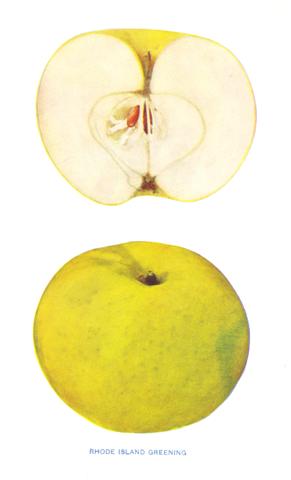 You
might guess that Rhode Island Greening is a green apple. It
does
turn a bit yellowish as it ripens. And, actually, the
Greening
part might have come from a Mr. Green from Green's End near Newport,
Rhode Island, as early as 1748. It was extensively cultivated
in
New York and other areas in the 19th century. Rhode Island
Greening is an excellent cooking apple as well as a dessert apple.
The fruit is above medium to large, sometimes very large and
is
round to roundish oblate. The yellowish flesh is very firm
but
tender, juicy, sprightly subacid to somewhat acid. It has
also
been described as "peculiarly flavored." You
might guess that Rhode Island Greening is a green apple. It
does
turn a bit yellowish as it ripens. And, actually, the
Greening
part might have come from a Mr. Green from Green's End near Newport,
Rhode Island, as early as 1748. It was extensively cultivated
in
New York and other areas in the 19th century. Rhode Island
Greening is an excellent cooking apple as well as a dessert apple.
The fruit is above medium to large, sometimes very large and
is
round to roundish oblate. The yellowish flesh is very firm
but
tender, juicy, sprightly subacid to somewhat acid. It has
also
been described as "peculiarly flavored."
|
Sheepnose
(Black Gilliflower)
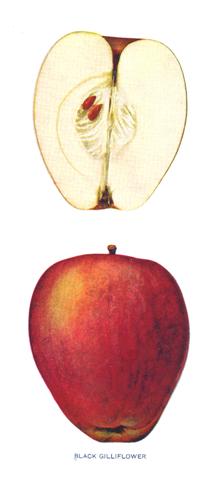 Sheepnose,
or Black Gilliflower, is one of those apples I began growing due to
family history. One day in my grandad's later years, when he
was
beginning to suffer from memory loss, I sat with him and told him about
the beginnings of my apple orchard. He was a lifelong dairy
farmer and had always had a few apple trees around, and he perked up as
I talked. Then he told me how he remembered those "sheepnose
apples" from when he was a boy. That sold it, I was going to
plant Sheepnose, and I did. Now, having grown Sheepnose, I
have
to say that they are not a good eating apple. However, they
are a
great baking apple and they are also good for drying.
Sheepnose
is shaped a bit like a sheep's nose. It is elongated and
smoothly
round. And it can turn a dark purple in color, giving it the
moniker of "black" in its other name. "Gilliflower," by the
way
refers to a spicy or aromatic scent. The flesh of Sheepnose
is
creamy white, moderately fine and very dry. It is the dryness
that makes them hard to eat out of hand, but excellent for baking.
They hold their shape in pies and have a very nice flavor.
If you like a dryer apple, try one for fresh eating.
Otherwise, I highly recommend this old (about 1841) apple for
baking, or try slicing and drying in the oven for a snack. Sheepnose,
or Black Gilliflower, is one of those apples I began growing due to
family history. One day in my grandad's later years, when he
was
beginning to suffer from memory loss, I sat with him and told him about
the beginnings of my apple orchard. He was a lifelong dairy
farmer and had always had a few apple trees around, and he perked up as
I talked. Then he told me how he remembered those "sheepnose
apples" from when he was a boy. That sold it, I was going to
plant Sheepnose, and I did. Now, having grown Sheepnose, I
have
to say that they are not a good eating apple. However, they
are a
great baking apple and they are also good for drying.
Sheepnose
is shaped a bit like a sheep's nose. It is elongated and
smoothly
round. And it can turn a dark purple in color, giving it the
moniker of "black" in its other name. "Gilliflower," by the
way
refers to a spicy or aromatic scent. The flesh of Sheepnose
is
creamy white, moderately fine and very dry. It is the dryness
that makes them hard to eat out of hand, but excellent for baking.
They hold their shape in pies and have a very nice flavor.
If you like a dryer apple, try one for fresh eating.
Otherwise, I highly recommend this old (about 1841) apple for
baking, or try slicing and drying in the oven for a snack.
|
Smokehouse
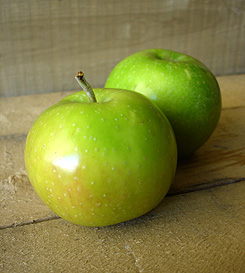 Smokehouse
originated with William Gibbons at Lampeter Township, Lancaster County,
Pennsylvania where the original tree grew near his smokehouse.
It
was brought to commercial notice by 1837, although it had been locally
propagated prior to that. It is thought to be a seedling of
Vandevere. The fruit is medium to large and roundish oblate.
Coloring is varied, often varying between green and red with
patches of orange. The skin is thin, easily allowing
bruising.
The flesh is tinged with yellow, firm, fine and crisp.
It
is juicy, mild subacid and delicately aromatic. In plain
terms,
it has a "different" flavor and the bruised apples make a welcome
addition to cider. Smokehouse
originated with William Gibbons at Lampeter Township, Lancaster County,
Pennsylvania where the original tree grew near his smokehouse.
It
was brought to commercial notice by 1837, although it had been locally
propagated prior to that. It is thought to be a seedling of
Vandevere. The fruit is medium to large and roundish oblate.
Coloring is varied, often varying between green and red with
patches of orange. The skin is thin, easily allowing
bruising.
The flesh is tinged with yellow, firm, fine and crisp.
It
is juicy, mild subacid and delicately aromatic. In plain
terms,
it has a "different" flavor and the bruised apples make a welcome
addition to cider.
|
Spitzenburg
(Esopus Spitzenburg)
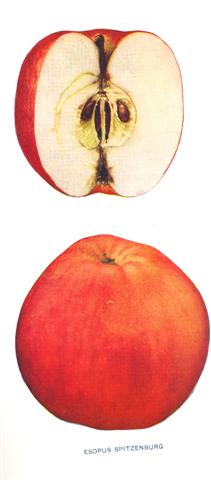 Spitzenburg
is widely associated with Thomas Jefferson. So I think it apt
to
use this description of the apple by Peter J. Hatch, Director of
Jefferson's Monticello Gardens and Grounds, January 1995 (from the Twinleaf
Journal of
the Thomas
Jefferson Foundation): Spitzenburg
is widely associated with Thomas Jefferson. So I think it apt
to
use this description of the apple by Peter J. Hatch, Director of
Jefferson's Monticello Gardens and Grounds, January 1995 (from the Twinleaf
Journal of
the Thomas
Jefferson Foundation):
Although
Jefferson never planted the Spitzenburg in large quantities,
there are more documentary entries concerning its planting than for any
other fruit variety. The Esopus Spitzenburg was discovered early in the
eighteenth century at Esopus (pronounced today as "Eee-soap'-us")
along the Hudson River sixty miles north of New York City, presumably
by
one of the horticulturally astute Dutch settlers named Spitzenburg.
Lady
Jean Skipwith, an avid and proficient eighteenth-century Virginia
gardener,
proclaimed it "the finest American table apple next to the Newtown
Pippin." In the nineteenth century, the Spitzenburg was the
most
universally
acclaimed of all apple varieties. America's first published pomologist,
William Coxe, said it "possesses great beauty, and exquisite flavor;"
A. J. Downing, a singular figure in the history of United States
horticulture,
described it as "a handsome, truly delicious apple . . . unsurpassed
as a dessert fruit;" and S. A. Beach, author of The Apples of
New
York and usually frugal in his praise, said the Spitzenburg
was "unexcelled
in flavor and quality." The Spitzenburg is easily identified
by its vivid, orangish-red
skin.
Biting into a Spitz produces an explosion of flavors. The yellow flesh
is crisp, firm, spicy, and juicy with an extremely rich, aromatic
flavor: the ultimate gourmet apple.
|
Suncrisp
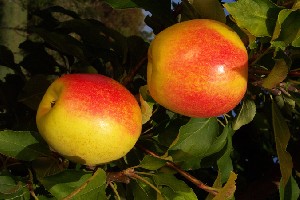 Suncrisp
is a patented variety out of Rutgers University and the New Jersey
Apple Breeding Program. It comes from a cross between
Golden Delicious and Cox
Orange Pippen and retains the best qualities
of both. The fruit color is golden with an orange blush.
This dual-purpose apple has a sweet, mildly subacid taste, and
typically stores up
to six months. It is very juicy like Golden Delicious and
has some of that apple's spicy aroma as well. Suncrisp
is a patented variety out of Rutgers University and the New Jersey
Apple Breeding Program. It comes from a cross between
Golden Delicious and Cox
Orange Pippen and retains the best qualities
of both. The fruit color is golden with an orange blush.
This dual-purpose apple has a sweet, mildly subacid taste, and
typically stores up
to six months. It is very juicy like Golden Delicious and
has some of that apple's spicy aroma as well.
|
Washington
Strawberry
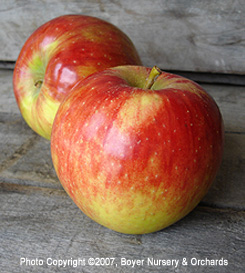 Washington
Strawberry, like Sheepnose, has a family connection for me.
After
a hot, crazy Independence Day (July 4) family reunion one year, I went
home with my grandparents for a visit. In the calm of that
evening, I talked with them about my new apple orchard. My
grandmother mentioned that when she was a child she had
enjoyed
the "strawberry" apples that were grown in the area, saying that they
tasted like strawberries. So in her honor I planted some.
Washington Strawberry originated in New York around 1849.
It
is a colorful, roundish apple with a waxy skin colored with reds over
yellows and some striping. The flesh is creamy yellow, crisp
and
juicy, somewhat coarse, but tender. The name "strawberry"
comes
from its slight strawberry-like taste but you may or may not agree with
that comparison. Otherwise, the taste is sweet and spritely. Washington
Strawberry, like Sheepnose, has a family connection for me.
After
a hot, crazy Independence Day (July 4) family reunion one year, I went
home with my grandparents for a visit. In the calm of that
evening, I talked with them about my new apple orchard. My
grandmother mentioned that when she was a child she had
enjoyed
the "strawberry" apples that were grown in the area, saying that they
tasted like strawberries. So in her honor I planted some.
Washington Strawberry originated in New York around 1849.
It
is a colorful, roundish apple with a waxy skin colored with reds over
yellows and some striping. The flesh is creamy yellow, crisp
and
juicy, somewhat coarse, but tender. The name "strawberry"
comes
from its slight strawberry-like taste but you may or may not agree with
that comparison. Otherwise, the taste is sweet and spritely.
|
Winesap
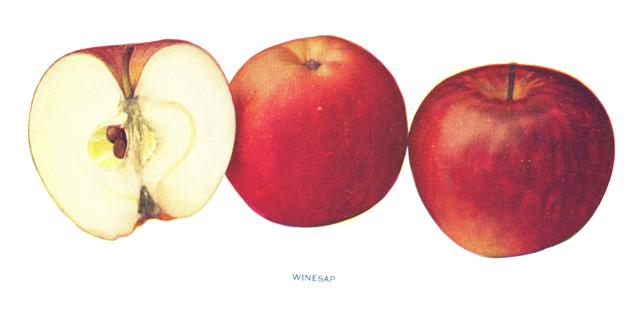 Winesap
is one of the oldest and, at one time, most popular apples in America.
It is thought to have originated in New Jersey and was
commercially important there as early as 1817.
These days, it is known synonymously with it's child, Stayman
Winesap. Winesap is not a large apple. It is
conical to
roundish with a medium-thick skin that is deep red with some striping
and blotching or dark purple. The flesh is tinged yellow,
very
firm and coarse, and moderately crisp. It is very juicy and
sprightly subacid in flavor, which some say has a hint of wine flavor. Winesap
is one of the oldest and, at one time, most popular apples in America.
It is thought to have originated in New Jersey and was
commercially important there as early as 1817.
These days, it is known synonymously with it's child, Stayman
Winesap. Winesap is not a large apple. It is
conical to
roundish with a medium-thick skin that is deep red with some striping
and blotching or dark purple. The flesh is tinged yellow,
very
firm and coarse, and moderately crisp. It is very juicy and
sprightly subacid in flavor, which some say has a hint of wine flavor.
|
Yellow
Newtown Pippin
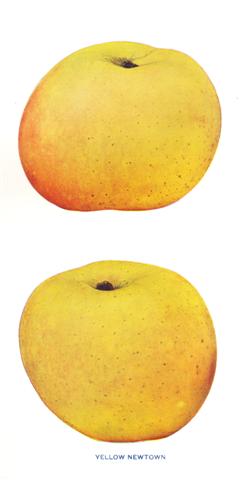 Yellow
Newtown Pippin is a very old variety of apple. It was the
first
American apple which attracted attention in Europe and was sent there
commercially by Benjamin Franklin as early as 1759. Thomas
Jefferson wrote of it in his "Garden Book" in 1773 and noted in 1778
that he had Newtown Pippin growing at Monticello. Yellow
Newtown
Pippin is a long-keeping variety, but is difficult to grow due to its
high susceptibility to apple scab (a fungal disease). The
fruit
is medium to large and shape is variable, usually roundish and oblate.
Flesh is yellowish, crisp, tender, moderately fine-grained,
juicy, subacid, and aromatic. The term, pippin, refers to the
origin of the tree being from a chance seedling rather than from a
deliberate cross of varieties or grafting of a sport (mutation) from a
known tree. Yellow
Newtown Pippin is a very old variety of apple. It was the
first
American apple which attracted attention in Europe and was sent there
commercially by Benjamin Franklin as early as 1759. Thomas
Jefferson wrote of it in his "Garden Book" in 1773 and noted in 1778
that he had Newtown Pippin growing at Monticello. Yellow
Newtown
Pippin is a long-keeping variety, but is difficult to grow due to its
high susceptibility to apple scab (a fungal disease). The
fruit
is medium to large and shape is variable, usually roundish and oblate.
Flesh is yellowish, crisp, tender, moderately fine-grained,
juicy, subacid, and aromatic. The term, pippin, refers to the
origin of the tree being from a chance seedling rather than from a
deliberate cross of varieties or grafting of a sport (mutation) from a
known tree.
|
Yellow
Transparent
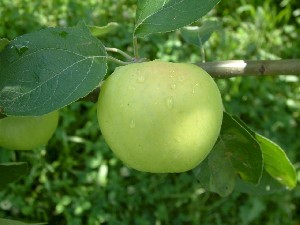 Yellow
Transparent is an old, early-ripening variety from Russia
(1870),
ready in late July to early August.
The fruit is tender, juicy, and mildly acid, making it a
favorite
for homemade applesauce.
If you don't eat them
right away, best to make applesauce, as they do not store well.
Yellow Transparent has a large round fruit and, as the name
suggests, the skin is somewhat transparent. Yellow
Transparent is an old, early-ripening variety from Russia
(1870),
ready in late July to early August.
The fruit is tender, juicy, and mildly acid, making it a
favorite
for homemade applesauce.
If you don't eat them
right away, best to make applesauce, as they do not store well.
Yellow Transparent has a large round fruit and, as the name
suggests, the skin is somewhat transparent.
|
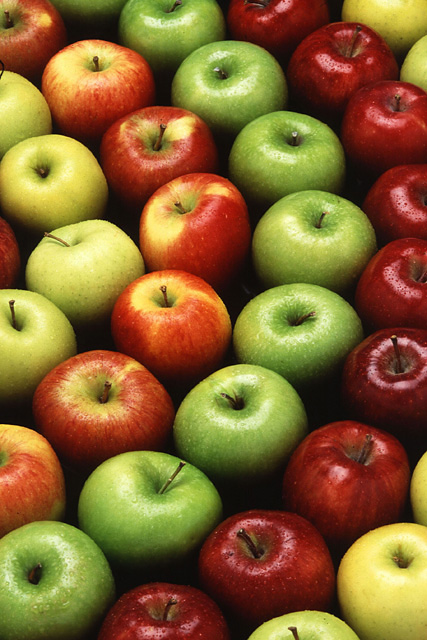 Apple Varieties
Apple Varieties




















